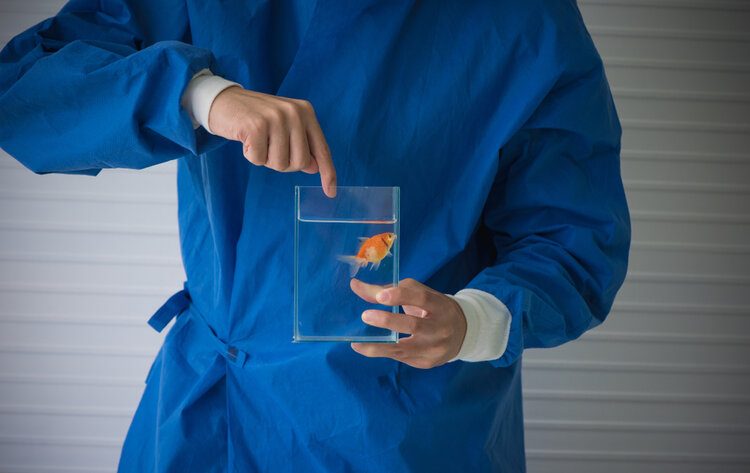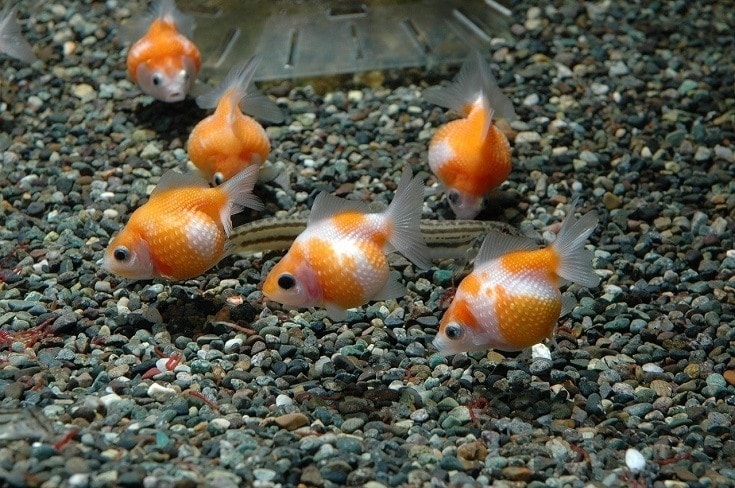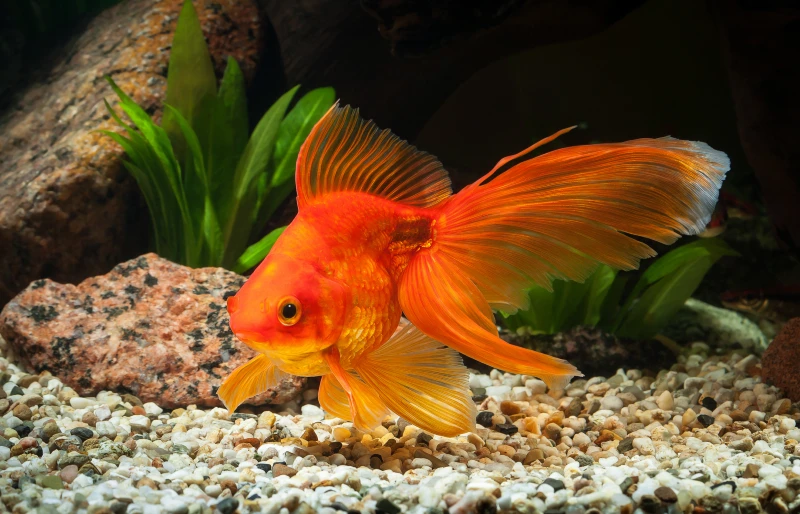Wakin Goldfish: Pictures, Size, Care, Tank Setup, & More
Updated on
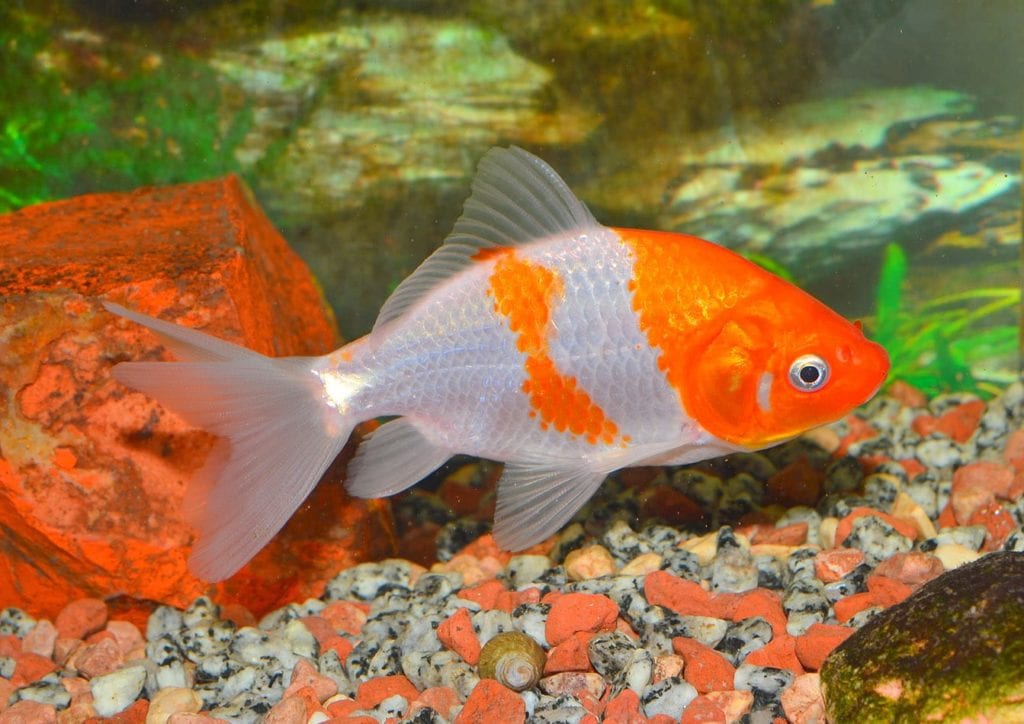
The Wakin is a rare variety of Japanese goldfish that has been around since the 1500s. They are one of the oldest varieties of Japanese goldfish that have been introduced from China. Wakin goldfish resemble common goldfish and the crucian carp by their shape, size, and hardiness.
Some of the oldest literature on Japanese goldfish depicts the Wakin as a colorful stream-lined goldfish that can be found in three tail varieties.
| Size: | Up to 12 inches long |
| Lifespan: | 10–15 years |
| Similar Breeds: | Comet, Jikin, and Shubunkin |
| Suitable for: | All goldfish keepers |
| Temperament: | Peaceful and social |
Wakin goldfish can only be found in the aquarium pet trade, as they do not naturally exist in the wild. Many of the goldfish varieties available today have been cultivated from the Wakin goldfish, like the Watonai and Nishiki goldfish.
Their ease of care and hardy nature makes the Wakin goldfish a good choice for both novice and experienced goldfish keepers. The Wakin goldfish can thrive in both outdoor ponds and indoor aquariums, provided that they have plenty of swimming space.
If you are interested in caring for the rare Wakin goldfish, this article will tell you everything you need to know.
Wakin Goldfish Characteristics
How Much Do Wakin Goldfish Cost?
The Wakin is considered a rare variety of goldfish, despite their ancient history. Like many other goldfish varieties, the Wakin’s origins can be traced back to China. They were likely bred from a Chinese goldfish before being introduced to Japan and where the variety was further modified.
It is rare to find Wakin goldfish in most pet stores, and they are not as widely available as many other goldfish varieties. If you want a true Wakin goldfish with a pure bloodline, the best place to purchase them is going to be from a breeder. The breeder should ideally specialize in breeding Japanese goldfish with physical characteristics that are true to the particular goldfish’s standards.
If you cannot find a Wakin goldfish breeder, your next best option is an online retailer. Some websites that sell aquarium fish sell Wakin goldfish. However, there is no guarantee that the goldfish you are purchasing is a true Wakin goldfish.
Regardless of where you purchase them from, Wakin goldfish typically cost between $30 to $150. You can expect to pay more for a large Wakin goldfish rather than small Wakins (under 4 inches).
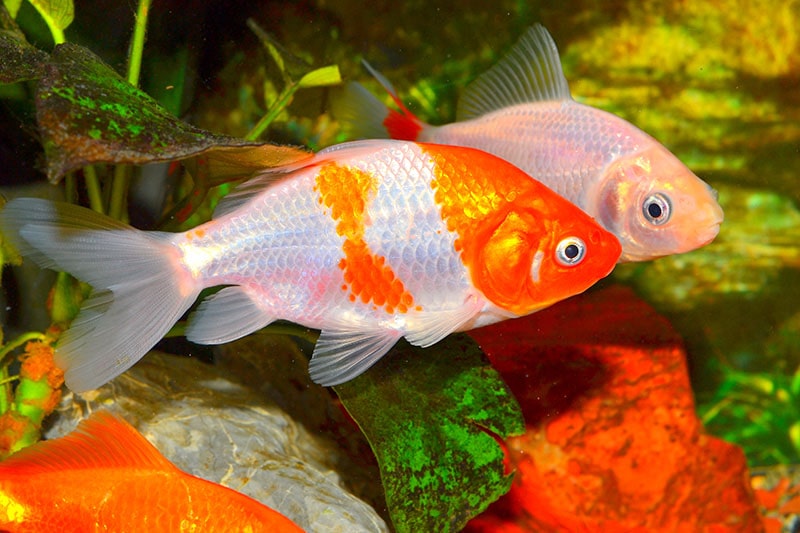
Sociability of the Wakin Goldfish
Do These Fish Make Good Pets?
Wakin goldfish make very good pets for goldfish lovers. This variety of goldfish is known for being peaceful, social, hardy, and adaptable. These are excellent qualities that many goldfish enthusiasts look for in a goldfish. As a variety of goldfish with a streamlined body, the Wakin is not as delicate as fancy goldfish are. Wakin goldfish can live in ponds, and they have very similar housing requirements to other streamlined goldfish like the comet.
If you do decide to get a Wakin goldfish, keep in mind that they can get very big. Most goldfish are still very small when you get them but have the opportunity to grow into a 12-inch-long adult. Therefore, Wakin goldfish should not be kept in small aquaria like bowls, vases, and tanks under 40 gallons in size. They require a filter too, since all varieties of goldfish produce high waste bioloads.
Does This Fish Make a Good Tankmate?
The Wakin goldfish is a highly social fish that needs to be kept in pairs or groups of other goldfish. They make good tank mates for other similarly sized streamlined goldfish, but they make poor tank mates for other species of fish.
You generally want to avoid housing Wakin goldfish with any tropical fish species due to the difference in water parameters. Any large and aggressive fish should not be housed with Wakin goldfish since they could cause injury or stress them out.
The more delicate varieties of fancy goldfish like the Pearlscale, Oranda, Ranchu, and Lionhead goldfish are not the best tankmates for Wakins. This is primarily because the Wakin is a streamlined goldfish that has few limitations when swimming, searching for food, and interacting with other fish.
However, many varieties of fancy goldfish have been bred to have abnormally large bellies, head growths, and sometimes no dorsal fin. This makes them slow swimmers that do not thrive in outdoor ponds or the same tank as streamlined goldfish. Wakin goldfish will be the first to the food, leaving the delicate goldfish unable to eat.
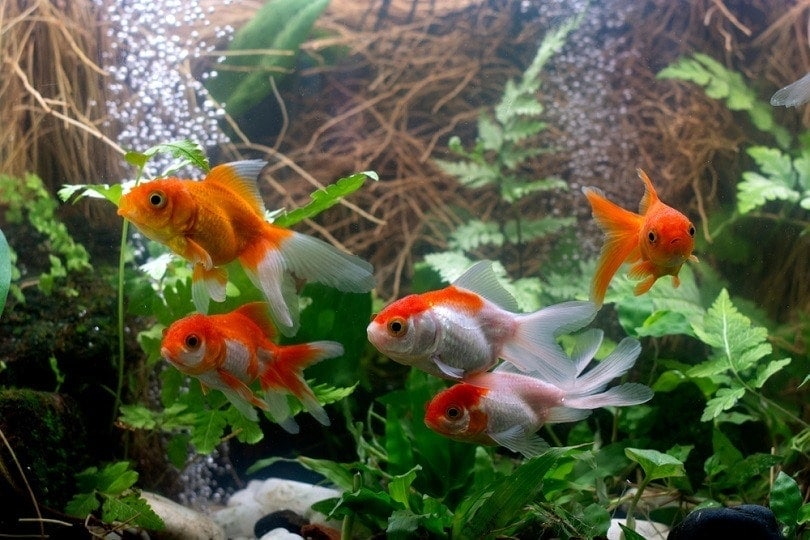
Care Guide & Tank Set Up
Wakin goldfish are large fish that can be kept in outdoor ponds, pools, and very large aquariums. Juvenile Wakin goldfish should have at least 40 gallons of water for themselves. However, they do need to be kept in pairs or groups, so the size of their aquarium will need to be larger than this. For a pair or group of three Wakin goldfish, 75 gallons of water is recommended.
Some adult Wakin goldfish are better suited for outdoor ponds over 200 gallons in size, considering they grow to 12 inches long.
Water Quality, pH, & Temperature
| Temperature: | 65°–75° Fahrenheit (18°–23° Celsius) |
| pH range: | 0–8.0 |
| Ammonia level | 0 ppm |
| Nitrite level: | 0 ppm |
| Nitrate level: | Below 20 ppm |
The Wakin goldfish is a cold or temperate water fish that does not need a heater to thrive. They can survive in temperatures as low as 50 degrees Fahrenheit and as high as 80 degrees Fahrenheit. However, they are much more comfortable in water between 65 to 75 degrees Fahrenheit. Their wide temperature tolerance range is what makes them suitable for outdoor ponds.
A very important aspect of Wakin goldfish aquariums is the water quality. They should only be kept in cycled aquariums with no traces of ammonia or nitrate. Wakin goldfish can become very ill from even the slightest level of ammonia or nitrate in the water. However, they are more forgiving of nitrates up until 20 ppm.
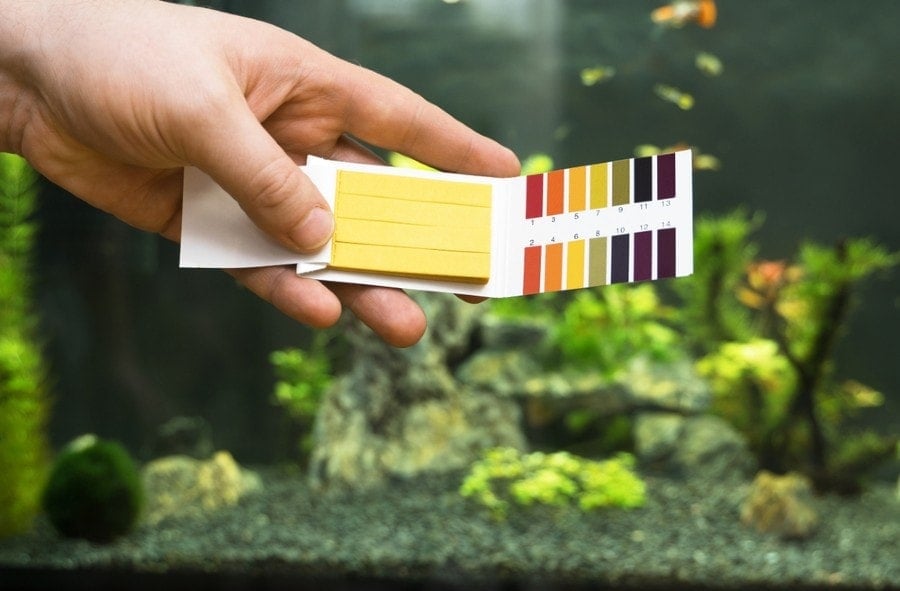
Substrate
A substrate is not a necessity for Wakin goldfish ponds or tanks. You can leave them bare since it is not only costly but difficult to maintain the large amount of substrate it would take to fill their aquariums. However, a substrate can be beneficial for Wakin goldfish as it’s a growth medium for live plants and encourages foraging behavior. Wakin goldfish enjoy foraging in the substrate in search of leftover food.
If you decide to add substrate to your Wakin goldfish aquarium, you have several options to choose from. Substrates like sand, fine gravel, and quartz sand are preferred by Wakin goldfish. You want to avoid pebbles or large pieces of gravel as a substrate since they can be a choking hazard.
Plants
Live aquatic plants can be beneficial for Wakin goldfish. Plants offer them a more naturalistic environment that encourages them to explore while offering them a sense of security. Furthermore, plants also play a role in improving water quality by using nitrates for growth. Keep in mind that Wakin goldfish may nibble or uproot plants since some plants are tasty to them.
Best Plants for Wakin Goldfish:
- Water lettuce
- Hornwort
- Water sprite
- Duckweed
- Frogbit
- Java fern
- Water hyacinth
- Anubias
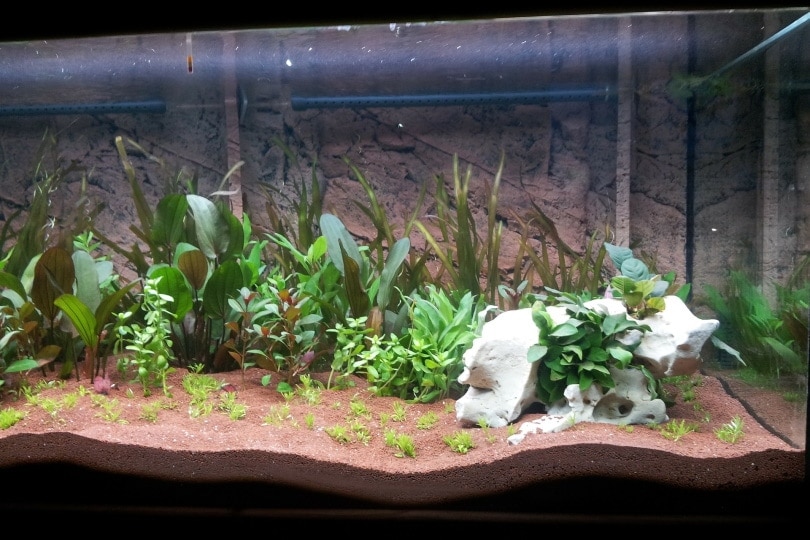
Lighting
Wakin goldfish do not need very bright aquarium lighting, with low or moderate light being preferred. Very bright lighting can be stressful for Wakin goldfish, and the reflective properties can make them feel disorientated. If you grow any live plants in your Wakin goldfish tank, you will need to use overhead aquarium lighting. Regardless, Wakin goldfish need a period of light for 6 to 12 hours a day, and a period of total darkness to rest. Goldfish do not have eyelids, so darkness is necessary for them to rest.
Filtration
A filter is crucial for a Wakin goldfish’s overall health. All goldfish are messy fish that produce high bioloads. They are messy eaters and poop continuously since food passes quickly through their intestines. Wakin goldfish need a powerful filter that is compatible with the size of their tank or pond. The filter will aerate the water, process waste products, and prevent the water from becoming stagnant.
You can use simple filtration systems like a sponge filter for Wakin goldfish, or more lavish ones like a canister filter. However, the filter should not create a strong current in the water.
Things to Know When Owning a Wakin Goldfish
Wakin goldfish care is beginner friendly. They have similar care requirements to other common goldfish varieties and do not have any special dietary needs.
Food & Diet Requirements
All varieties of goldfish are omnivores. This fish naturally eats a diet consisting of animal and plant-based foods and enjoys a varied diet. A Wakin goldfish’s main source of nutrition should be from a flake, granule, or pellet food formulated for goldfish. There are many great brands of goldfish food out there, but some are of higher quality than others.
You ideally want to feed Wakin goldfish a high-quality food that contains nutritious ingredients and a blend of vitamins and minerals. It is also a good idea to supplement a Wakin goldfish’s diet for variety and additional nutrition.
Foods like bloodworms, tubifex worms, brine shrimp, and algae wafers are excellent supplements to goldfish diets. They can be offered to goldfish up to four times a week in addition to their main diet.

Size & Growth Rate
Most Wakin goldfish reach an adult length of 10 to 12 inches, but there are reports of some reaching 16 inches in length. It seems that Wakin goldfish grow much larger in ponds rather than in tanks. This is likely due to the larger volume of water in ponds which benefits Wakin goldfish in several ways. Wakin goldfish rely on a spacious aquarium, clean water, and a balanced diet for growth.
It can take a couple of years for Wakin goldfish to reach their full size since their growth is dependent on several environmental factors. You may find that Wakin goldfish grow very slowly in small fish tanks or bowls since this is an unsuitable environment for them.
Varieties
The Wakin itself is a variety of common goldfish that has a streamlined body shape. Their spine seems to curve to the base of their caudal (tail) fin, giving them a slightly humped appearance. Their body is slightly wider from their anal to dorsal fin, but shorter in length than comet goldfish. Wakin goldfish have large and prominent metallic scales and can be found in many different colors.
The most common color form seen in Wakin goldfish is red and white. However, they can be found in colors like plain red, black, orange, white, silver, blue, brown, grey, yellow, and olive. Although Wakin goldfish have been found with calico markings, it is unlikely that they are pure Wakin goldfish.
A distinguishing feature of the Wakin goldfish is their three-tail varieties. They can have a single, double, or triple tail. The Wakin goldfish’s tail description can vary by location since not each tail variety is widely available. Most Wakin goldfish in the United States have a double tail, while a divided fantail-like fin is most common in Japan. They have long dorsal fins and either double or single anal fins.
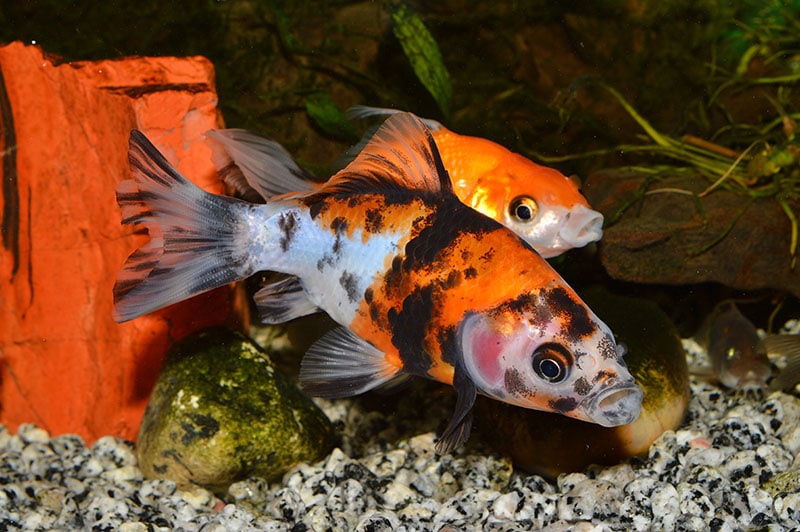
Lifespan and Health Conditions
The Wakin goldfish is a very hardy and healthy goldfish that is not susceptible to certain health problems like fancy goldfish. With proper care and a spacious aquarium, most Wakin goldfish have an average lifespan between 10 to 15 years. However, they can live longer depending on how well their environment is maintained and their type of care.
Although they are relatively healthy fish, they are not exempt from the same health conditions as any other variety of goldfish.
- Cataracts
- Neurofibromas (warts)
 Male vs Female
Male vs Female
| Male Wakin Goldfish: | Female Wakin Goldfish: |
| Breeding tubercles | Rounder stomach |
| Longer and pointier fins | Less prominent fins |
| Concave vent | Convex vent |
| Chasing behavior during spawning | Deposits eggs during spawning |
3 Little-Known Facts About Wakin Goldfish
1. Wakin goldfish are a rare variety of goldfish with an ancient history.
2. You can find Wakin goldfish in many different colors, including rare colors like olive and silver.
3. Wakin goldfish have three different tail variations—single, double, and triple divided.
Conclusion
Wakin goldfish make good additions to ponds or very large aquariums due to their hardiness and extensive temperature range. These rare fish have an average size of 10 to 12 inches and will grow rapidly in the right conditions. The key to a healthy and happy Wakin goldfish is a spacious aquarium that is equipped with a powerful filter with well-maintained water quality. Wakin goldfish can be found in various colors and tail variations, making them one of the most vibrantly colored varieties of goldfish.
If you care for Wakin goldfish properly, they are hardy enough to survive for around 10 to 15 years, and sometimes even longer.
Featured Image Credit: JuanCarlosPalauDiaz, Shutterstock


